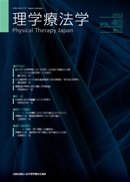All issues

Volume 24, Issue 2
Displaying 1-5 of 5 articles from this issue
- |<
- <
- 1
- >
- >|
Reports
-
Yuri YONEZAWA, Norihiko YAGIArticle type: Article
1997Volume 24Issue 2 Pages 55-60
Published: March 31, 1997
Released on J-STAGE: September 25, 2018
JOURNAL FREE ACCESSIn order to investigate the actual condition of housing renovation of patients with rheumatoid arthritis (RA), 50 chronic RA patients whose class was whether 2 or 3 were interviewed.
As a result, drastic renovation was observed in the washroom, where the patients showed high independency. On the contray, renovation of the bathroom and the entrance hall had some difficulty in improving the independency. Among the minor changes frequently observed, many thoughtful alterations of movement without renovation were made at the door and inside the tub. Handrails of the washroom were found the most impractical renovation.
The result of our survey suggests that thoughtful alteration of movement and minor renovation of housing are important for chronic RA patients whose clinical symptoms are apt to change.View full abstractDownload PDF (628K) -
Mitsunobu YATSUNAMI, Michiyo KAMISAKO, Satoshi ENDO, Sanae TERAKADO, S ...Article type: Article
1997Volume 24Issue 2 Pages 61-68
Published: March 31, 1997
Released on J-STAGE: September 25, 2018
JOURNAL FREE ACCESSA survey was conducted to determine the actual status of activities of daily living (ADL; functional independence measure: FIM), health behavior (degree of self-management ability in regard to health), mental state (presence or absence of insomnia, anxiety, depressive tendency, loss of interest), and quality of life (QOL; Life Satisfaction Index-A: LSIA) in 183 hemiplegic patients attending the outpatients clinic. Methods of analysis consisted of performing simple tabulations and analysis of variance focusing on age and lower extremity Brunnstrom stage.
The result for ADL revealed a high degree of independence on the FIM (mean score: 78; maximum score: 91), and health behavior was good (mean score: 19 points; maximum score: 20 points), but assessment of mental state yielded high percentages of patients (40%-50%) with insomnia, anxiety, depressive tendency, and loss of interest. The result for QOL revealed a low percentage with a positive response to life.
Analysis of variance showed a main effect of age or lower extremity stage on ADL, health behavior, mental state, and QOL. However, no interactions were found.
According to the results of this survey, many of the hemiplegic patients being seen in the outpatient clinic had a high degree of independence in regard to their ADL, and their health behavior was also good. However, the psychological aspects and QOL were low, suggesting that evaluation and support are necessary, including psychosocial aspects.View full abstractDownload PDF (917K) -
Shigekazu YOSHIMURA, Takayuki TAGUTI, Naoe MIYASHIRO, Tetuo IKAIArticle type: Article
1997Volume 24Issue 2 Pages 69-74
Published: March 31, 1997
Released on J-STAGE: September 25, 2018
JOURNAL FREE ACCESSThe purpose of this study was to evaluate unilateral leg press muscle strength and body weight ratio, obtained by dividing unilateral leg press muscle strength by body weight, in female rheumatoid arthritis patients (RA group) and healthy aged women (aged group) as indicators of ability to support body weight on one leg.
The RA and aged groups consisted of six and of fourteen subjects, respectively. Unilateral leg press muscle strength and body weight ratio were determined at knee angles of 15, 30, 45, 60 and 75 degrees.
Unilateral leg press muscle strength and body weight ratio in the RA group were 35-44% and 50-62%, of those in the aged group, respectively. An association was noted between the body weight ratio and the ability to support the body in the standing position on one leg.
These findings suggest that unilateral leg press muscle strength and body weight ratio in the RA group are about half their levels in the aged group, and thus, the ability to support body weight on one leg is lower in the RA group. It has also been suggested that body weight ratio can be used as an indicator for ability to support the body in the standing position on one leg.View full abstractDownload PDF (592K) -
Hiroyuki FUJISAWA, Naoki SUENAGA, Akio MINAMI, Kazuhiro ISHIDAArticle type: Article
1997Volume 24Issue 2 Pages 75-81
Published: March 31, 1997
Released on J-STAGE: September 25, 2018
JOURNAL FREE ACCESSThe purpose of this study was to analyze the EMG activity from eight volunteers during lift-off test (middle, low and high position) and internal rotation exercise at flexion 0°, abduction 90°and maximal elevation of shoulder. Nine muscles were studied: the subscapularis, two parts of pectoralis major (clavicular and costal), latissimus dorsi, three parts of the deltoid (anterior, middle and posterior), supraspinatus and infraspinatus. Two kinds of exercises, active and maximal resistive isometric exercises, were studied. The EMG signals were low-pass filtered, full-wave rectified and integrated. Moreover, the EMG activity was quantified as a percentage of the maximal manual muscle test (%MMT). The results showed that the activity of the subscapularis increased selectively during active lift-off test at all positions, compared with the other muscle activities. However, the activity of the lattisimus dorsi also increased during lift-off test at maximal resistive isometric exercise, and there was no significant difference between the activities of subscaplaris and lattisimus dorsi. Moreover, the activity of subscapularis only increased during maximal resistive isometric exercise at maximal elevation of shoulder. Both the maximal resistive isometric exercise at maximal elevation of shoulder and lift-off test are thought to be reciprocally important for the clinical maneuver of isolated rupture or the decrease of muscle strength of subscapularis.View full abstractDownload PDF (1318K)
Note
-
Yasuhiko Eguchi, Atsushi Doi, Hideaki Fujimoto, Shinichi Nojiri, Ryoji ...Article type: Article
1997Volume 24Issue 2 Pages 82-84
Published: March 31, 1997
Released on J-STAGE: September 25, 2018
JOURNAL FREE ACCESS
- |<
- <
- 1
- >
- >|